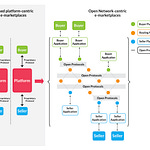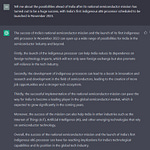Siliconpolitik: The Upcoming Quad Summit
-Pranay Kotasthane
News reports suggest that the first in-person Quad summit is likely to be held in September. The last online summit-level meeting created three working groups on vaccines, critical & emerging technologies (C&ET), and climate change.
Though there has been some action on vaccine delivery, there are virtually no updates about the outcomes of the other two working groups. At least on the C&ET front, it seems to me that a vast agenda has bogged down any meaningful collaboration. To this day, it seems that the four countries do not even agree on which technologies are critical and emerging, and which aren’t.
The four states will be looking for ways to get out of this rut as they meet in September. Hence it is useful to recommend C&ET ‘actionables’ that can be announced as part of this summit.
I have earlier written why a semiconductor partnership would be an ideal start for the Quad C&ET collaboration. In this edition, here are a few tangible action items to begin this partnership.
One, announce a Quad Semiconductor Supply Chain Resilience Fund. Think of this as a multi-sovereign wealth fund but for semiconductor investments across the Quad countries. This fund could focus on two areas:
create a roadmap for new manufacturing facilities across the Quad countries. One of the focus areas should be to secure supplies not just at the leading-edge nodes but also at key trailing-edge nodes, which will continue to remain workhorses for automotive, communications (5G), and AI.
Sponsor new standard developments such as composite semiconductors and create one centre for excellence in each Quad country in an area of its immediate interest. For example, Australia could host the CoE for new materials in electronics, Japan could host the CoE for silicon manufacturing equipment, while the US and India could host CoEs on specific fabless design architectures.
Two, and this one is an even more ambitious goal, facilitate strategic alliances between companies in the four quad states.
A precedent to learn from is the US-Japan arrangement in the early 1990s by when memory manufacturing had moved out from the US to Japan for cost reasons. The US National Research Council came out with a report in 1992 studying the types of alliances between US and Japanese semiconductor companies and recommended specific actions to take in furthering each of these arrangements.
For example, the table below captured the sixteen types of alliances used by US and Japanese semiconductor companies.

Nearly thirty years later, this typology remains a useful guide for Quad collaboration on semiconductors. Each area needs government facilitation. For example, reducing export control requirements between quad countries can aid more licensing, cross-licensing, and technology exchange arrangements. Similarly, lowering investment screening mechanisms for quad countries can accelerate joint development and acquisition arrangements.
In short, there is much that can be done on the Quad C&ET agenda through the siliconpolitik route.
Mineralpolitik: The Global Hustle for REEs
-Aditya Pareek
Rare Earth Elements(REE) are critical to modern high-tech supply chains. China has captured much of the Rare Earths market over the past three decades. One reason for this has been its willingness to bear the steep ecological cost of extracting and processing REEs.
In 2010, during a dispute between China and Japan, the world got its first memorable jolt of how China’s dominance of the sector can affect the supply of everything - from strategically important tech to consumer electronics. Ever since, the need for diversifying and building separate supply chains not reliant on China has been felt and the COVID-19 induced disruption has only exacerbated these impulses.
However, according to recently published data, as quoted in SCMP and Reuters, China’s Rare Earths exports have proliferated by a significant margin (25.3% compared to the first half of 2020 and 16.5% compared to the first half of 2019). While the US and other Quad states may be planning to shift away from China, it will take years for this to become a reality.
According to an opinion piece in the Diplomat, Myanmar, which saw a military coup earlier this year, and has again become a pariah state to the West, is the “third-largest source of mined Rare Earths”. Most of these mines from which Mayanmar’s REEs come are in the long-troubled Kachin state region.
Dysprosium is an important REE component in Neodymium magnets which in turn are used to build everything from basic motors in consumer electronics and appliances like cars, washing machines to all conceivable complex military equipment such as drones, combat vehicle engines, submarine electric propulsion systems etc.
“The price of dysprosium oxide shot up nearly 60 percent in March, amid fears that prolonged unrest in Myanmar could tie up shipments of ores and concentrates.”
As this feature in Mining Technology highlights, Tanzania can also soon emerge as a major supplier of very “high-grade neodymium praseodymium (NdPr) deposits in the world”. The neodymium supply, if it materialises, will be an important new source for building REE permanent magnets that are imperative to most modern systems civilian and military.
An alternative source of REEs, apart from traditional mining methods, maybe urban mining, which is basically recycling REEs from scrapyards and garbage dumps containing REE rich e-waste. Until now, this hasn’t been a source of a significant amount of the world’s REE supply but as this article in Ars Technica points out over time it may emerge as a major source.
If the content in this newsletter interests you, consider taking up the Takshashila GCPP in Technology Policy. It is designed for technologists who want to explore public policy. By the end of this course, you will be able to use a #ResponsibleTech framework to systematically understand the ethical dimensions of technology advancements.
Intake for the 30th cohort ends on 22nd August. To know more click here.
Cyberpolitik #1: The Secret’s Out
-Nitansha Bansal
It is happening again! Proof of global surveillance exercised by the states has once again come to light, this time in the form of the Pegasus Project. It is a coordinated effort of Forbidden Stories, a French media non-profit, and Amnesty International. Eighty journalists from ten countries collaborated to unearth the global spying tool with the technical support of Amnesty’s Security Lab which conducted forensic tests to identify the traces of Israeli cybersecurity firm NSO’s spyware called Pegasus.
Spyware is malicious software that enters a device, gathers data and transmits it to a server without the consent of the owner of the data. Pegasus is such a powerful cyber-surveillance tool that it is classified as a weapon and requires the same export clearances as a lethal weapon, explains Suhasini Haider, the Diplomatic Affairs Editor of The Hindu.
Once injected into the target’s device, it can read messages and mails, access call logs and stored files, switch on and off the device, turn on the camera and microphone, and can even affect the devices near the targeted device, without the knowledge of the device owner. Until 2018, NSO relied on Enhanced Social Engineering Message (ESEM) i.e. a malicious SMS or a WhatsApp message to inject Pegasus into the target’s device. However, the latest version of Pegasus is a zero-click spyware i.e. spyware that does not need the target to click on any link or pick any calls. The target does not need to interact with the spyware. It can enter the target’s device merely by sending a push notification or by sending a missed call to the device.
In 2016, Canadian Citizen Lab first flagged the cybersecurity threat presented by Pegasus to Apple. Then in 2019, WhatsApp blamed the NSO for exploiting a zero-day vulnerability in its video calling feature to inject spyware into users’ devices. Citizen Lab reported again in 2020 about governments using Pegasus to spy on journalists at Al Jazeera and Al Araby TV. Now, the Pegasus Project has reportedly revealed over fifty thousand targeted contact numbers which are mostly concentrated in Azerbaijan, Bahrain, India, Kazakhstan, Mexico, Morocco, Rwanda, Saudi Arabia, Hungary and the United Arab Emirates (UAE).
State surveillance is not new. What is new is the ease of surveillance and the engagement of the private sector in mass surveillance.
Also new is the Internet of Things (IoT), which could allow objects of daily use like cars and kitchen equipment to provide information about owners. It was with Edward Snowden’s revelations in 2013 that the world realized the omnipresence of the state in their daily lives.
The symbiotic relationship between government spies and private companies has changed surveillance. Commercial corporations provide the technology, equipment as well as required information on citizens to government agencies in the form of online payment, searches, shopping, social media etc.
What is also worth noticing in the case of Pegasus is the export of surveillance technologies from one country to another. NSO has maintained that the Israeli Minister of Defence has to approve NSO’s clients to make sure that the spyware is not used against Israel or its interests.
I wonder if categorising nations as democratic or authoritarian has become archaic. We would do more justice to contemporary times if we compared governments on the basis of the mass surveillance they conduct on their own.
Cyberpolitik #2: Digital Communication Networks and their harms
-Prateek Waghre
Digital Communication Networks (defined below) have led to concerns about rapid changes in the scale and structure of human networks, their impact on the quality of the information in circulation, and the role played by algorithms in directing the flow of information. Seventeen researchers have called for the study of collective behaviour to be elevated to a ‘crisis discipline’.
A Takshashila Working Paper published earlier this week categorised the various harms attributed to Digital Communication Networks (DCNs). We define DCNs as composite entities consisting of the following components:
Capability: Internet-based products/services that enable instantaneous low-cost or free communication across geographic, social, and cultural boundaries. This communication may be private (1:1), limited (1:n e.g. messaging groups), or broad (Twitter feeds, Facebook pages, YouTube videos, live streaming ), and so on.
Operator(s): Firms/groups that design/operate these products and services.
Networks: The entities/groups/individuals that adopt/use these products and services, and their interactions with each other.
We did this because we felt existing terms such as ‘social media’, ‘big tech’, ‘digital platforms’, can be limited by context-dependence, or be too broad or too narrow. The proposed framing, we believe, encourages their study from the perspective of their effects on societies as a whole, rather than focussing on specific companies, technologies, sharing mechanisms, user dynamics, and other attributes which are constantly evolving.
The paper classifies the harms attributed based on whether they have competitive, data-related or narrative effects.

It then categorises these harms as potential market failures (3), social problems (13) and cognitive biases (9). The wide range of social problems and cognitive biases highlight the need for further study of the psychosocial effects of these harms and their broader impact in the Indian context. These considerations also raise the questions of how, and whether, the antitrust interventions currently being pursued in some of the developed economies will affect DCNs across competition, data and narrative spheres in the rest of the world.
This is the first in a series of papers that will explore the different aspects of DCNs. Future work will investigate the benefits that DCNs enable, assess overlaps and contradictions between proposed or enacted DCN governance measures, and examine the role of global internet governance mechanisms.
You can read a pdf version of the paper here.
Our Reading Menu
[Report] Some very useful conceptual thinking on what AI means for national power by the folks at Center for Security and Emerging Technology.
Takshashila’s A Rare Earths Strategy for India [Discussion Document]
Dr Yamuna Singh’s [Book] is the most comprehensive volume on the scientific and pragmatic context of REE extraction and processing in India.
Kim Zetter’s [Book] Countdown to Zero Day.
Andy Greenberg’s [Book] Sandworm.











Share this post